It’s funny how I think I know the history of the Pasadena Art Museum, when all I’m doing is projecting back and assuming a bunch of stuff based on a bunch of great-sounding anecdotes:
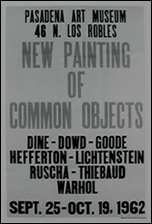 First museum shows for Duchamp, Lichtenstein, Warhol; Walter Hopps and the ur-Pop Art show; great posters [Ruscha, Duchamp, Warhol]; Pasadena Brillo Boxes; Serra’s massive 1970 fir tree installation; the increasingly intrafamily-related theft of Norton Simon’s nephew’s Warhols; Lichtenstein signing his Pasadena billboard.
First museum shows for Duchamp, Lichtenstein, Warhol; Walter Hopps and the ur-Pop Art show; great posters [Ruscha, Duchamp, Warhol]; Pasadena Brillo Boxes; Serra’s massive 1970 fir tree installation; the increasingly intrafamily-related theft of Norton Simon’s nephew’s Warhols; Lichtenstein signing his Pasadena billboard.
But then I read through Paul Cummings’ 1975 AAA interview with John Coplans, artist, Artforum co-founder & editor, and former Pasadena curator and director, and it sounds like the place was a total shitshow:
ladies’ auxiliaries overruling curators to keep buying local artists’ crap; architects calling the fire department on curators for hanging shows; firemen ripping lights and cords off of Rauschenbergs; trustees scheduling Warhol shows with Castellis behind their curators’ and directors’ backs; trustees not putting up a dime, or asking their friends to donate; trustees demanding shows that include work they own who then sell that work without notice a few weeks before the opening; and people freaking the hell out when some crazy East Coast guy with a Jewfro drops a dozen fir trees in their precious museum and calls it art.
And on and on. There are definitely some additional sides to the stories I’d love to hear: trustee/collector Robert Rowan, for one. He’s the guy who was apparently running the show during the late 60s, and who plotted the Warhol show with Castelli. And whose Temple of Apollo painting was featured so prominently on Lichtenstein’s billboard.
Also, Norton Simon, who apparently refused to lend all kinds of stuff as a trustee, but who obviously made a deal at some point, otherwise it’d still be called the Pasadena Art Museum.
Hopps, of course. Irving Blum, who drove around LA with a bottle rack in his trunk, waiting to get Duchamp to sign it. Even though a lot of folks have died, there are still plenty who are alive and perhaps willing to talk.
UPDATE: Well this sounds like a start. Tyler points to Susan Muchnic’s 1998 biography Odd Man In: Norton Simon and the Pursuit of Culture, which apparently “comes alive” with accounts of “the bizarrely bitter politics of Los Angeles museums.”
Author: greg
I Rumori Dell’Arte
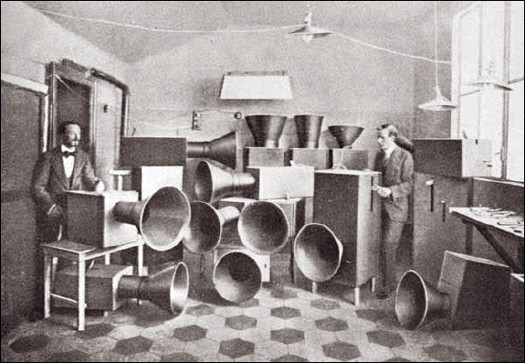
That’s Futurist painter Luigi Russolo on the left being helped by his friend Ugo Piatti, probably around 1913 or 1914. They stand amidst Russolo’s musical instruments, intonarumori, noise-intoners, which were designed in accordance with the principles laid out in Russolo’s Futurist music manifesto, l’Arte dei Rumori, The Art of Noise.
Though the trajectory of his ideas and influence is not quite as clear as The Hydra’s otherwise excellent recounting of his legacy imputes, Russolo was an innovator and visionary in the use of noise, found sound, in musical composition.
In The Art of Noise, Russolo makes a bold, lucid argument for music of the future to adopt the sounds of the world, especially the sounds of the machine, which had irrevocably changed the world’s aural landscape:
Ancient life was all silence. In the nineteenth century, with the invention of the machine, Noise was born. Today, Noise triumphs and reigns supreme over the sensibility of men. For many centuries life went by in silence, or at most in muted tones. The strongest noises which interrupted this silence were not intense or prolonged or varied. If we overlook such exceptional movements as earthquakes, hurricanes, storms, avalanches and waterfalls, nature is silent.
…
In the pounding atmosphere of great cities as well as in the formerly silent countryside, machines create today such a large number of varied noises that pure sound with its littleness and its monotony, now fails to arouse any emotion.
Then there’s this, the source noise for his Intonarumori, the sounds of the modern world:
the gurglings of water, air and gas inside metallic pipes, the rumblings and rattlings of engines breathing with obvious animal spirits, the rising and falling of pistons, the stridency of mechanical saws, teh loud jumping of trolleys on their rails, the snapping of whips, the whipping of flags. We will have fun imagining our orchestration of department stores’ sliding doors, the hubbub of the crowds, the different roars of railroad stations, iron foundries, textile mills, printing houses, power plants and subways. And we must not forget the very new noises of Modern Warfare.
Indeed. Russolo’s first public demonstration of Intonarumori was in Modena in April 1913. An instrument called the scoppiatore variously called the exploder or crackler, it replicated the sound of an internal combustion engine, not, actual explosions. That would be the detonatore, which came soon after.
I realize that it was not mentioned specifically in Russolo’s list of noises, but how can you not think of hail cannon when you see that photo up there? Russolo was born in 1885 in the formerly silent countryside of the Veneto, which was at the heart of the hail cannon boom [sorry] at the turn of the century. Thousands of hail cannon were installed across the region in 1901-02; in 1904, the Veneto was the site of the first official scientific study of hail cannon’s effectiveness. [They failed, and once-enthusiastic farmers turned against them en masse and sold their hail cannon for scrap.]
Did Luigi perhaps recall a pastoral orchestra of hail cannonfire from his youth when he wrote his manifesto? I have no idea, but it’s interesting to think about. None of the intonarumori recordings on Ubu sound like the modern hail cannon these guys try to throw their Barack Obama basketballs into.
On an object note, Russolo’s original Intonarumori were destroyed or scrapped, but his nephew Bruno Boccato has refabricated some following his uncle’s original plans. I think these are they.
Oh, And Hail Cannon. Must. Remake. The Hail Cannon.
Good grief, it was only a couple of hours ago, and I can’t even remember what took me to this three-year-old link roundup on BLDGBLOG that mentions hail cannons. I mean, hail cannon.
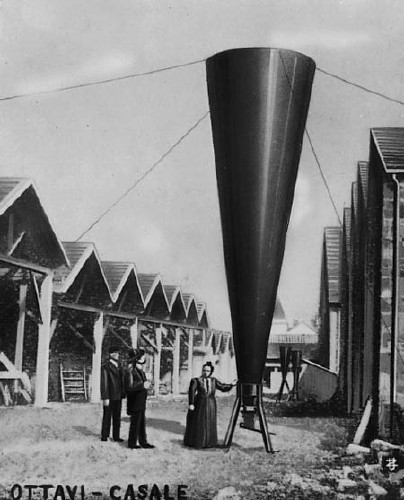
Turns out they still make’em, they just don’t make’em like they used to. It’s something that the Wikipedia entry on hail cannon calls them “pseudoscientific” devices. Because whatever scientific data exists for them now–and it’s not at all clear that there is much/any–it’s pretty obvious that hail cannon are technotheoretical holdovers from the turn of the 20th century.
The promise of vintners being able to their crops by creating and channeling explosive shockwaves to pulverize hail in the hyperlocal atmosphere had been shooting around Europe since at least the days of Benvenuto Cellini, the Mannerist goldsmith & sculptor who claimed to have stopped the rain and hail with artillery fire.
Between 1896 and 1899, Austrian inventor Albert Stiger tested his design for a giant, megaphone-shaped mortar cannon that fired a smoke ring 300 meters into the air–and spared his village fields from hail damage. The Italians seized upon the hail shooting technology with incredible fervor, and within a year, there were 10,000 hail cannon protecting the vineyards of Northern Italy.
The first two International Congresses on Hail Shooting were held in Italy [Casale in 1899, and Padua in 1900], by which point at least 60 different models of hail cannon were on the market. So far, though, neither event was as extensively documented as the Troisième Congres international de defense contre la grêle, [the Third International Congress on Hail Shooting,] held in Lyon in 1901 [below, via]
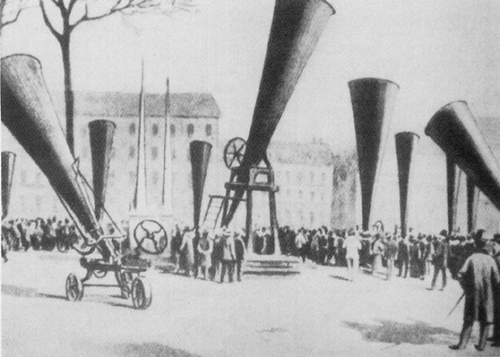
For three days, the streets, parks, and plazas of the cities were filled with hail cannon. Were there live demos scheduled? Did people lay out picnics [well, it was Novembre] and listen to the big finish of the 1812 Overture over and over? Did the vineyards of Europe, laid out with a grid of hail cannon–an anti-Lightning Field–echo with rhythmic explosions during the most vulnerable months of the growing season? [Did I suddenly start speculating as if were auditioning for the guestblogging slot at BLDGBLOG?]
Eh, if they did, it didn’t last. Governments and scientists began questioning the data behind hail shooting, and by the time the Fourth conference rolled around in Graz, Austria, hail cannon salesmen were prohibited from attending. Suddenly sober and facing the facts–that hail shooting couldn’t be demonstrated to actually have any effect–the European hail cannon industry all but disappeared by 1905.
And so it is that refilling our cities’ public spaces with several orchestrasful of hail cannon would be a powerful, performative tribute to man’s indomitable urge to control the weather using military technology.
Q: Why is this Romanian Wikipedia page on Hail Cannon so darn good? [ro.wikipedia.org]
Must. Remake. Acoustic Mirrors & Locators
My list of incredible objects and machines from the past that need to be refabricated as art objects continues to grow.

Actually, I guess the acoustic mirrors, built in the 1920s and early 30s as part of a sound ranging air defense network along the British coast, still exist, most spectacularly at Dungeness, above. So there’s really no need to rebuild them, only to preserve then. And admire them for their undeniable Serrawesomeness and Kapooriosity.
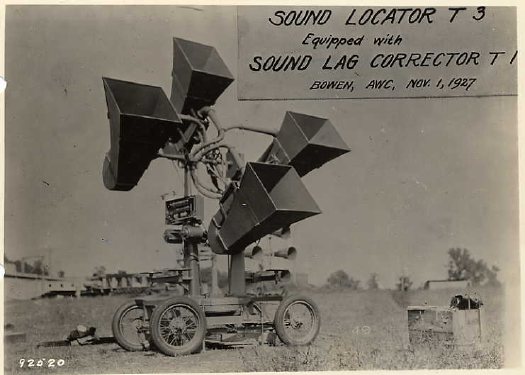
With the acoustic locators, however, the real question is where to start? Because, holy smokes, Dr. Seuss was basically a combat photographer.
Do I go with the first one I saw, a US Signal Corps Exponential Sound Locator T-3 from 1927? Which looks an awful lot like the one Frank House patented in 1929, which was assigned to Sperry Gyroscope, the US’ leading manufacturer of anti-aircraft sound locators? Yet which was developed beginning in 1924 at Fort Monroe, VA? And which, even when its breakthrough “ear” designs appeared in the popular press in 1931, was still compared to “antiquated phonograph horns”?
Or maybe go for decorative superlatives, such as the Hector Guimardian rarity of the télésitemètre designed by French Nobelist Jean-Baptiste Perrin? [via]
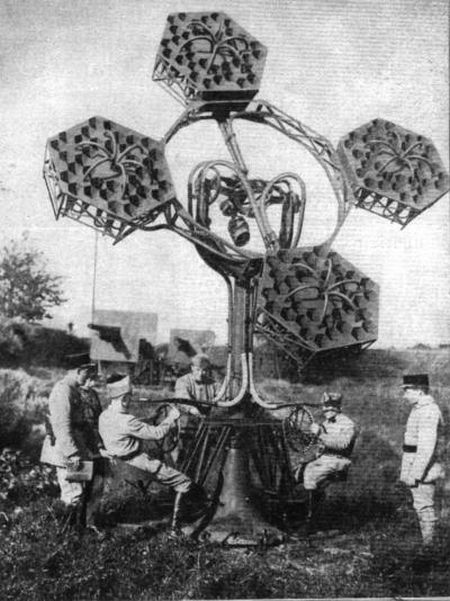
Or perhaps begin with a bit of the absurd, thanks to the Czech Mickey Mouse thing going on here? [via]

Frankly, the Japanese War Tuba is a little too Seussian Steampunk for even me to take it seriously, no offense to the emperor there. [via]
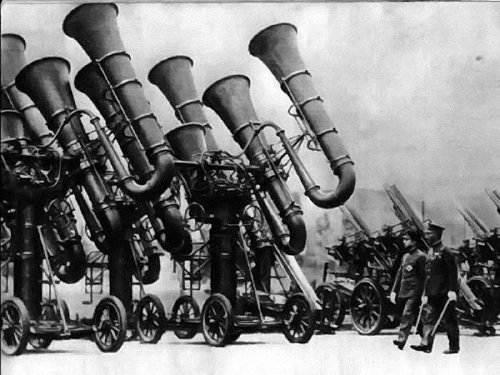
Surfing up information on these things, I’m well aware that I’m late to the sound locator game. But I didn’t think I was so far behind the Maker Faire/Burning Man crowd. Hmm. And hmmm.
Oh what the hell, maybe just throw this one on Governors Island and be done with it? The stethoscope to the stars.
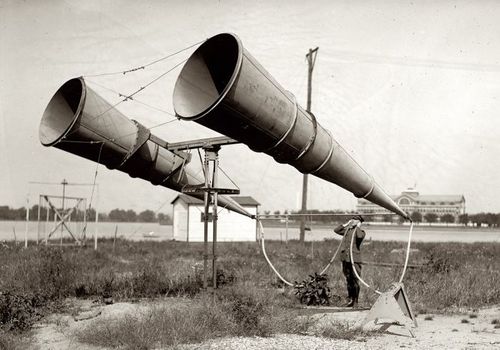
But then there’s this highly portable German model–the awesome wheels and lowslung platform are typical among acoustic locators–which, wow. Stick your head in.
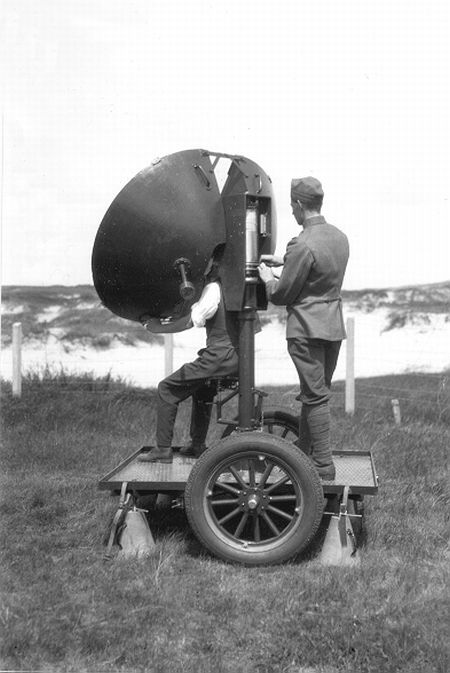
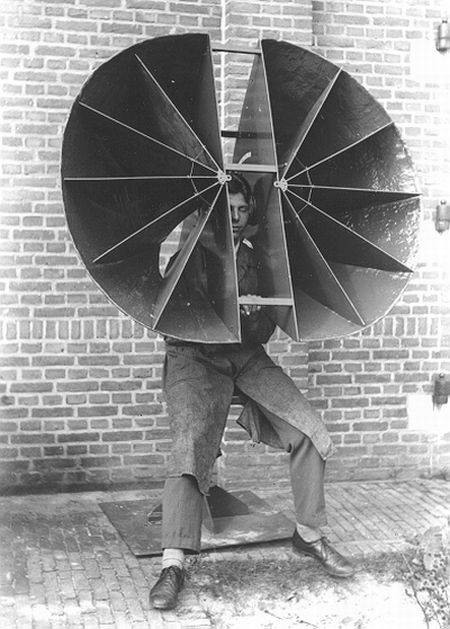
It’s like a real world precursor to other man-media interface devices, such as Walter Pichler’s Portable Living Room and Joep van Lieshout’s various fiberglass helmets, including the Orgone Helmet and the Sensory Deprivation Helmet [below].
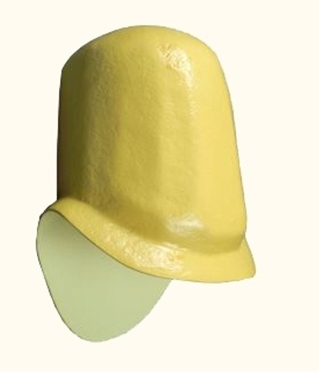
Of course, it’s also a pretty short trip to a beer hat, so you gotta be careful.
Also of course, as a friend predicted when I started my giddy sound locator rant, it IS all about the satelloons. Specifically, the 50-foot horn-shaped radio antenna which Bell Labs used in Holmdel, New Jersey to track the epically faint radio signals reflected off of Echo IA’s mylar surface.
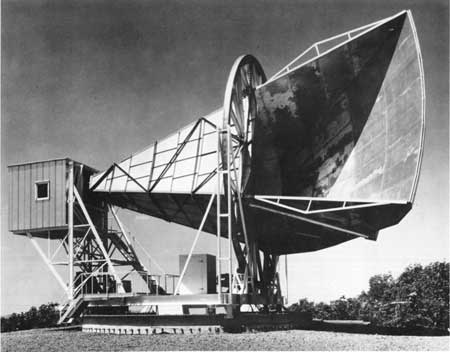
And which was later crucial to the inadvertent discovery of microwave background radiation, the first evidence of the Big Bang.
Earlier this morning, I tweeted half-seriously about the Bechers not working their way into The Original Copy, MoMA’s show about photography of sculpture. For all their conceptual sophistication, and their typological aestheticization to the industrial forms and structures they photographed, I don’t believe the Bechers saw their work in terms of, say, a readymade. Their art is their photos, not their subjects.
With their built-in obsolescence and anachronism, none of these objects could function as they originally did. Or were intended to do. And they don’t, really, remain as artifacts [except, as in the sound mirrors’ case, when they do]. So the only context in which they could plausibly exist–or credibly, since it’s plausible that they could be recreated by an enthusiast, a WWI re-enactor, or a nerded out…who is that guy in that refabricated sound locator, anyway?–is as an art object. And that’s the whole point, because they are these fantastic objects that surpass the presence and sophistication and beauty and…aura of so much intentional art, that it almost feels wrong not to appropriate or recontextualize or readymake them in somehow.
LATER THAT DAY UPDATE: Never mind. Going into my boxes, I see that, in fact, the title of the Bechers’ first book is Anonyme Skulpturen. Should’ve gotten the English edition after all. Stay tuned.
Yeah, well, in this 2000 interview with the Bechers, they talk about the beginnings of their work, which was considered “inartistic” by the art world of the day, the early 1960s. Bernd Becher: “To say, ‘This winding tower is an object, and it is just as interesting on its own terms’–that was not possible.” And then he talked about the urgency of photographing buildings they “didn’t like” which were slated for demolition, and explained not like them in terms of them not having “an aura.” So really, really, never mind.
Keeping Up With The Laurens

Good grief, The Hilfigers? Is anyone else old enough to remember the ads launching Tommy Hilfiger in the 80s? Just full page text:
Ralph Lauren
Calvin Klein
Perry Ellis
Tommy Hilfiger
Glad to see he’s returning to his desperate, striving, unoriginal roots.
Cretto Street View
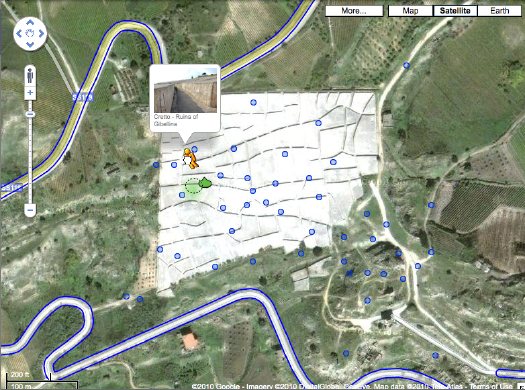
Christopher Knight took the occasion of an Alberto Burri retrospective in Santa Monica to tweet about Cretto, the artist’s absolutely incredible 20-acre memorial/earthwork, in which the earthquake ruins of the Sicilian town of Gibellina were encased in a grid of concrete. I’d mentioned Cretto in 2006, including a basic Google Map image.
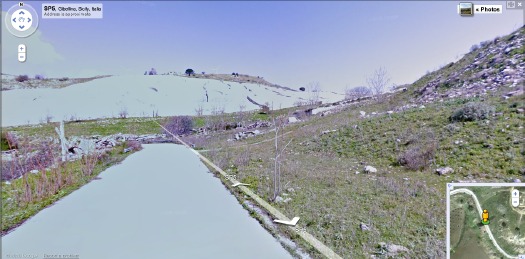
Well, Street View has come to Gibellina. At some point, I suspect no one will marvel at the idea of using your laptop to drive around the backroads of Sicily, or to dive into geotagged photos of remote land artworks. But that point is not yet. The Street View images in particular have a great, desaturated feel that makes me imagine I’m right there for the ribboncutting. The future and the past is now.
Cretto, Alberto Burri/Ruins of Gibellina [google maps]
Related: finding Double Negative has never been easier
‘We Who Change The World’
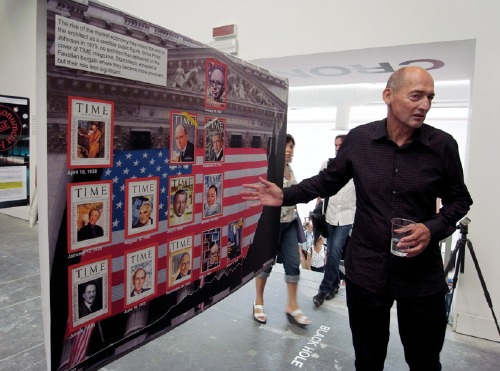
“My cover would go right here.” [image via]
Just like the Wallace Sayre quip about academic politics being so vicious because the stakes are so low, maybe the hubris and self-regard are so extraordinary because it’s the Venice Architecture Biennale. Anyway, let’s call it out quickly, and then look at what Rem Koolhaas has to say about modernism and preservation, because there may be some interesting things there.
[The text, by the way, is Designboom’s exhaustive 4-part guided tour (II, III, IV, pending) of “Chronocaos,” the OMA/AMO installation of research and history-related projects within Kazuyo Sejima’s exhibition.]
So. Hubris. Well, for starters, there’s the introductory wall text, which, wow:
Architects–we who change the world–have been oblivious or hostile to the manifestations of preservation the past. Since 1981, in Portoghesi’s “Presence of the Past,” there has been almost no attention paid to preservation in successive architecture Biennales.
I mean, I’m sure the visitors to the exhibition just ate that up, but should I even be reading it, much less commenting on it? Not being either an architect OR one who changes the world and all?
Then there’s the photo above, and its associated text:
The rise of the market economy has meant the end of the architect as a credible public figure.
Since Philip Johnson in 1979, no architect has appeared on the cover of TIME magazine.
Starchitects accepted a faustian bargain where they became more prominent, but their role less significant …
We’ll get to that public/market economy stuff in a minute; first let’s look at this Cover of TIME [CoTIME] business, which is as alluring as it is non-credible. [I was about to say “useless,” but really, it’s quite useful; it just illustrates something other than what I think Koolhaas intends.]
As it happens, Jonathan Franzen’s CoTIME this week gave Craig Ferhman the chance to do a similar CoTIME analysis for writers:
Time put 14 authors on its cover in the 1920s, 23 in the 1930s, seven in the 1940s, 11 in the 1950s, 10 in the 1960s, eight in the 1970s, four in the 1980s, four in the 1990s, one in the 2000s, and, now, Franzen in 2010.
Ferhman finds that behind the cover, TIME’s profiles of writers are truncated, shallow, reductivist, or otherwise nearly empty of actual content. He cites multiple examples of writers resisting the–what else to call it?– “faustian bargain” of a CoTIME, which was long considered uncritical, low-brow, and hypey. The cover becomes a thing in [and of] itself, a distillation of the magazine’s–and by direct extension, its owner’s–desire to assert authority and control over a cultural agenda.
In this light, and given the close tracking between architects’ and writers’ presence on the cover, one might be led to wonder if it’s not architecture [or literature] which has changed in the last 20-30 years, but TIME and its own role or strategy as a megaphone for culture. Or to question the suitability for a democratic society of monolithic, top-down annointing of public figures’ credibility. That one would not be Rem Koolhaas, though.
In any case, CoTIME reveals as little about the reported “end of the architect as a public figure” as it does about the ego-driven architect’s desire to, well, to appear on the cover of TIME.
And yet. You know, this is right where I was going to acknowledge and explore OMA/AMO’s more salient points, about how, as Designboom puts it,
…this year represents the perfect friction point between two directions: the world’s ambition to rescue larger and larger territories of the planet, and the global rage to eliminate the evidence of the post-war period of architecture as a social project. both tendencies–preservation and destruction–are seen to slowly destroy any sense of a linear evolution of time.
But I think I’ll take those up later. Because I just clicked through to see the CoTIME of the architect I thought would be the least likely candidate for a credible public figure in his day: a January 1963 story on Minoru Yamasaki.

1963. Which turned out to be pegged to his recent selection to design a 15-acre site for the Port Authority in downtown Manhattan:
What form the project may be taking in Yamasaki’s inventive mind is his secret, but simple arithmetic shows that the vast space needs and limited site could force him to record heights or bulk. One thing the center will not be is harsh or cold. In taking the road to Xanadu, Yamasaki has turned office buildings, schools, churches and banks into gentle pleasure palaces that are marvelously generous in spirit. He shuns monuments. He is suspicious even of masterpieces, which he feels often better serve the ego of their creators than the well-being of those who use them. He may have committed some architectural heresies, but if he has, it is largely because he is a humanist with enormously appealing aspirations. He wants his buildings to be more than imposing settings for assorted clusters of humanity; they should also recall to man the “gentility of men.” should inspire “man to live a humanitarian, inquisitive, progressive life, beautifully and happily.” However the Trade Center turns out, it will have that ideal– and it will be built with the ultimate degree of loving care.
It’s hard or impolitic to remember how reviled Yamasaki’s buildings were as architecture and as part of the city. But I don’t think anyone would dare argue about the World Trade Center that it was their architect who changed the world.
Keep Calm, Arts, And Carry On
Here [via COS] is David Shrigley’s animated short for Save The Arts, which is trying to help arts organizations in the UK avoid debilitating budget cuts.
At first, I thought WTF?? The Arts are so screwed! Then I thought, well, maybe they should’ve just gotten Nizlopi to do it. And then I thought for the whole “think of the children!” angle to work, it’d be nice if the kid–who HAS the arts right now, mind you–wasn’t an inert loser with less than three lines to string together. And then I saw, in my related videos selection, and I mellowed the heck right out.
Because Shrigley being Shrigley had previously saved Pringle of Scotland from being shuttered. Not only did he save Pringle, he helped get all the other jumpermakers bombed back to the sockmaking age.
And what did he save Pringle to do, you ask? Why, to commission Ryan McGinley to film Tilda Swinton’s exploration of the moody Highlands in Pringle eveningwear for the Spring/Summer 2010 collection:
And then it all came together when I saw the credit: Creative Director – Neville Wakefield, the great roving-so-as-not-to-have-to-give-up-too-many-side-gigs curator at PS1. I think the Arts will be just fine.
update: And a good thing, too, because Shrigley’s right: Tracy Emin’s not going to come put out your housefire. [via @bhoggard]
Take Ivy That

Ah, September 10th, an inadvertently trenchant date for unloading on the trendchasers’ seemingly complete lack of historical self-awareness.
And I’m not talking about that perfect, frivolous Marc Jacobs afterparty on that nearly perfect late summer evening which only acquired its poignancy the next morning when, well.
I just found this incredible wool twill authentic made in USA Ivy prep revival classic trad artisanal manly tweed outdoor ruling class WASP vintage Woolrich shirt jacket, which I’m rocking right now because it’s kind of chilly typing with the windows open.

See, I’d gone up to Connecticut Berkshires Brimfield North Adams Darien New Haven over the weekend. But since I had the car, I also stopped in Long Island City at our storage unit. And pulled a bunch of stuff out of a cedar-filled sweater suitcase I’d packed in 1995. I do believe it was vintage when I bought it in 1989.
It starts to feel like freakin’ Groundhog Day around here sometimes, but fortunately, I’m ready.
last year: authenticity vs. realness
Lichtenstein’s Electric Seascapes
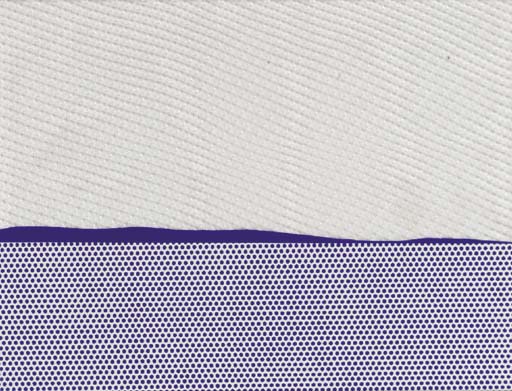
Seascape I, 1964, screenprint on Rowlux, ed. 200, from New York Ten portfolio [via]
You know how you just think you’ll blog about one thing, and then you want to get a little context, so you dig a bit, and then a bit more, and a bit more, and.. anyway, even though I rather obsessively collected out a bunch of his source comic books in the early 1990’s, I haven’t been a close follower of Lichtenstein’s work. Or rather, I think I’ve been lulled into a sense of familiarity by Lichtenstein’s almost immediate recognizability, and I never paid too much attention to when he made what and why or how. It just was.
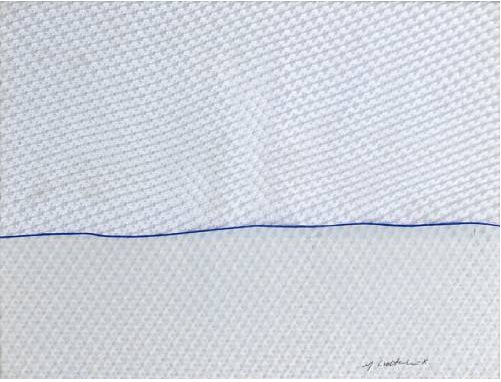
Seascape I, 1964, printer’s proof, Rowlux, different horizon, no Benday [via]
Which is why these early landscapes and seascapes are so fascinating. They’re so odd, so resolutely unfamiliar, almost unrecognizable as Lichtensteins, and yet they’re from 1964-68, a period when Lichtenstein’s career specifically and Pop Art generally were both gaining global recognition. They seem like experiments, avenues of persistent research. They account for some milestones: Lichtenstein’s first use of his own subject matter, inclusion in his first museum show. They have clear–or at least compellingly arguable–influence on later, major work. But they still somehow feel atypical, marginal, minor, dead-ends, even failed. But are they? Could they just be underseen or underappreciated? Undervalued by the market because they don’t “look” like Lichtensteins [yet]?
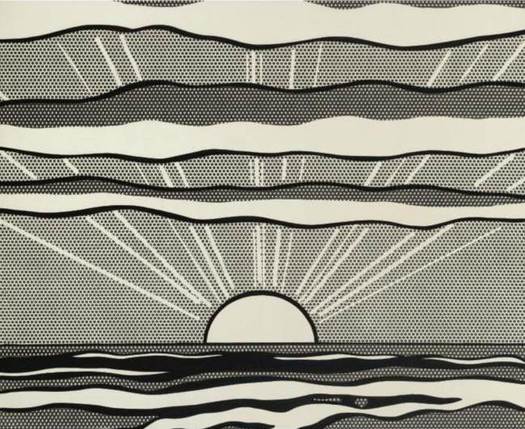
Black and White Sunrise, 1964, oil on magna on canvas [via]
According to the Roy Lichtenstein Foundation’s official chronology, the artist began making landscapes in early 1964. Some were painted rather spectacularly, like the black and white sunrise [above]. And with others:
Begins to incorporate plastic, Plexiglas, and metal into some of his landscapes.
And near the end of ’64, there’s this [images top]:
Rosa Esman begins Tanglewood Press with the portfolio, New York Ten which includes Seascape, 1964, a color screenprint on clear Rowlux by R.L.
Rowlux is a wavy, prismatic plastic sheeting material which Lichtenstein apparently discovered at a novelty store. Its moire pattern can simulate reflections on water. [Hmm, novelty shop? The Rowland brothers were trying to market Rowlux for use in highway signs, and according to Ron Abbe’s 1976 paper, “Experiment with Rowlux,” Salvador Dali was the first artist to use the material, in 1962. Dali decked some models out in Rowlux collages for a “couture” show in 1965. What a mess.]
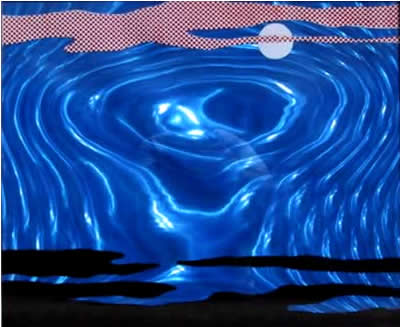
Moonscape, 1965, silkscreen on Rowlux, ed. 200 [image]
In 1965, Lichtenstein made painting collages using Rowlux and other materials. The dealer Mark Borghi, which is selling Littoral [below], lists some more. Littoral was purchased from Castelli by Larry Aldrich and made its way to his museum, which apparently deaccessioned it at some point.
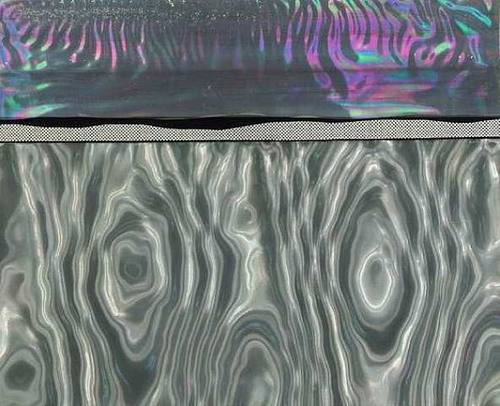
Littoral, 1965, Metalized polyester foil, aluminum and magna on board, [via]
1965 was also when Lichtenstein began experimenting with adding backlights and motors to his Rowlux painting collages, making them a hybrid of kinetic art, light art, and moving picture. Examples of these Electric Seascapes were included in the artist’s one-man show at the Pasadena Art Museum in 1967.
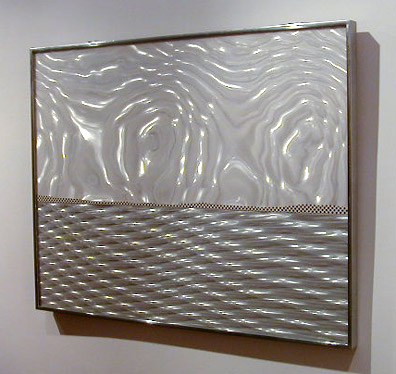
Electric Seascape #1, 1966, Rowlux, paper, light, electric motor, formerly Collection Guggenheim Museum [via]
I think two statements Lichtenstein made about his explosion paintings, which he began around the same time, are also relevant to these landscapes. First, from his interview with John Coplans for the 1967 Pasadena show catalogue, there’s a conscious technical distancing from painting: “I wanted the subject matter to be opposite to the removed and deliberate painting techniques.” And in Aspen No. 3, published in December 1966:
Explosions give me a perfect opportunity to do a completely abstract painting which seems, on the surface to he realistic.
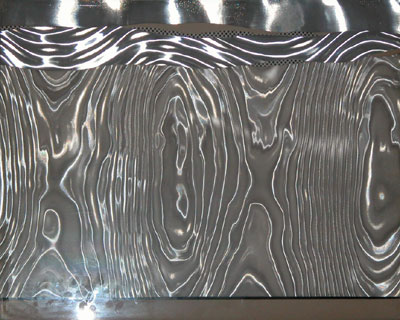
Electric Seascape #2, 1966, Rowlux, wood, light, motor [via]
While Moonscape is pretty strongly representational, many of these landscapes are as abstracted as Rothkos or Sugimoto photographs. Sometimes the only representational element is the hint of a Benday horizon contour–or the light playing on rippling water, which is, of course, an illusion intrinsic to the material itself.
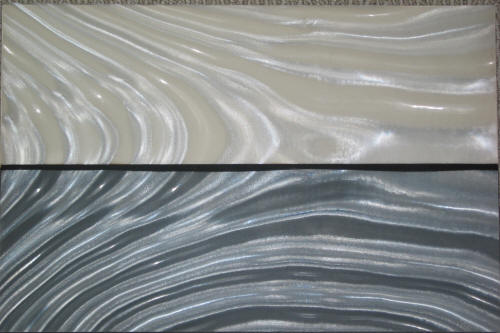
Landscape 2, 1967, silkscreen on Rowlux overlay, ed. 100 [via]
Lichtenstein kept on making these Rowlux collages and editions at least through 1967, when they were reduced to almost nothing but a horizon line. The two 1967 works here were from Ten Landscapes, Lichtenstein’s first solo print portfolio, published by Castelli.
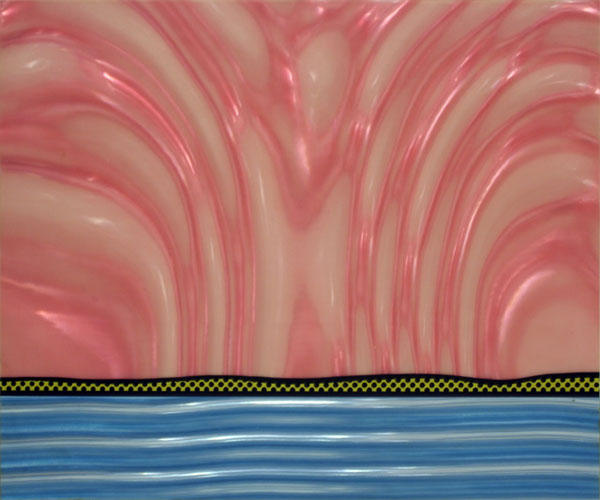
Landscape 5, 1967, silkscreen on Rowlux on board, ed. 100 [via]
When they were made, then, Lichtenstein’s hotness and Castelli’s marketing magic helped these trippy landscapes into major collections like the Guggenheim’s and Larry Aldrich’s. They were what’s available, and they got snapped up. And then at some point, those institutions decided they were expendable, or outside the Lichtenstein narrative, and they ended up back out into the market. Assuming it’s still available, Borghi’s Littoral has been on the market for at least two years.
Besides their intentional distance from the painting process–a major concern of almost all Lichtenstein’s work–these shimmery landscapes and seascapes are almost nakedly direct explorations of the characteristics of light, sight and visual perception. The play of light and reflectivity would become significant subjects for Lichtenstein going forward–his first painting of a mirror [below] was made in 1969. In 2000, an entire show of Lichtenstein’s light-related works, titled “Reflection/Reflessi,” was organized in Rome. The inclusion of Electric Seascape #1 only highlights the extent of Lichtenstein’s investigations.
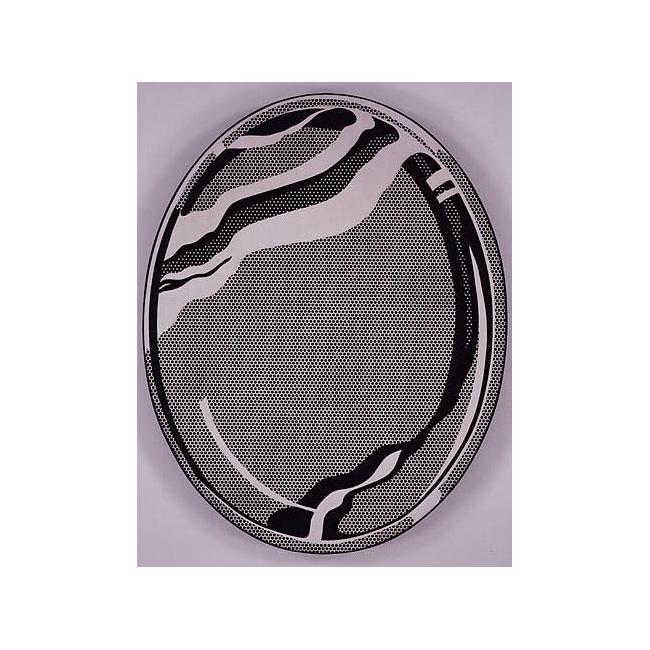
Mirror #1, 1969, oil on magna on canvas, [via]
But these landscapes also related directly to another series of unusual works, the ones that started me on this whole researching jag: Lichtenstein’s only films. Which are coming soon to a blog near you.
Now That’s A Fire!

This is why greg.org readers earn the big bucks, people. GF-R spotted this hilarious/sublime juxtaposition of ad and content from the LIFE Magazine report on the 1958 fire at the Museum of Modern Art and asks,:
coincidence? Or the work of the advertising and layout guys at LIFE? I’d love to know. The color image of the grilled cheese sandwich even looks like a proto pop art piece. (although I know there is no way of that being intentional and is only the result of my own retrospective anachronism).
Oh, I don’t know, someone check Claes Oldenburg’s resume for suspiciously ad agency internship-sized gaps. Meanwhile, add whoever designed that frying pan to the list of random cranks suing Damien Hirst for plagiarism.
Roy Lichtenstein’s Billboard Excursion, 1967
Over the weekend, I hit the road to interview some people I’ve wanted to meet and talk with for months now. I’ll be publishing the results soon here on greg.org. One of the artists whose work I’ve been interested in is Roy Lichtenstein. This wasn’t where I had planned to start my Lichtenstein story, but the beginning just keeps getting pushed back. And the Manitoba Museum of Finds Arts’ archive of Frank J. Thomas’s photos from the Pasadena Art Museum are just too awesome to ignore:
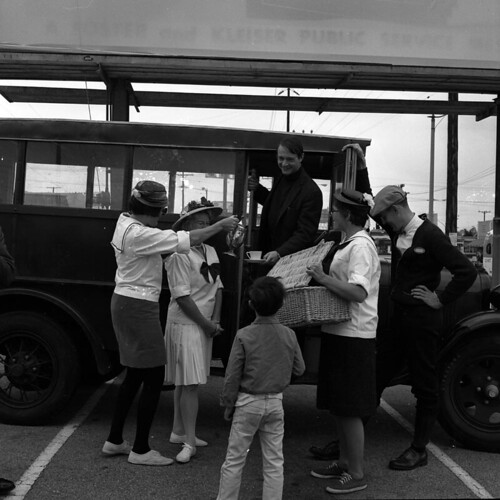
John Coplans gave Lichtenstein his first solo museum show in 1967, and while the artist was in Pasadena, the Museum organized a little excursion, which involved some old-timey outfits, and an old bus. And a ladder.
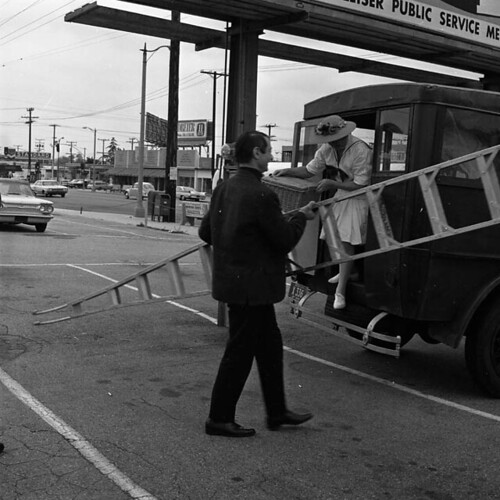
And a casual yet elegant affair in a Sears parking lot. A Sears promoting the–yes, you read that right–the “Vincent Price Art Collection.”
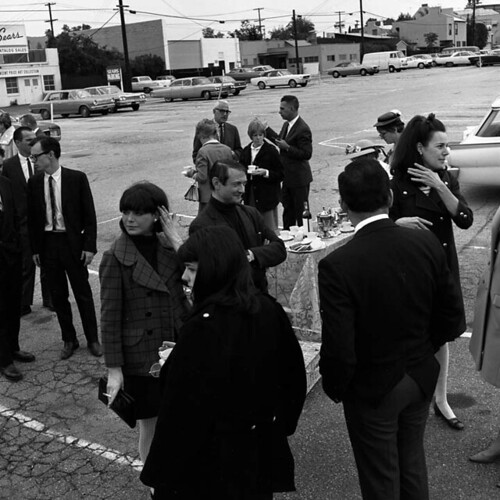
Roy climbed the ladder onto a Foster and Kleiser billboard.

And unveiled a giant billboard for his show, with what looks to be a life-sized reproduction of his 1964 painting, Temple of Apollo.

Which he promptly signed.

The Temple of Apollo was [is?] in a local Pasadena collection. The Billboard Temple of Apollo‘s fate and whereabouts are unknown, but I would start looking in either the Foster’s or the Kleiser’s garage.
update: Robert Rowan, a Pasadena trustee, bought the Temple. It’s mistranscribed in Castelli’s AAA interview as “tempo”.

Space Race
And in other Just Cold Stealin’ My Satelloon Idea Before The Fact News:

This has been stuck on my iPad for way too long. At a space flight conference a couple of months ago, the Global Aerospace Corporation announced their GOLD program, the Gossamer Orbit Lowering Device for controlled satellite de-orbiting.
GOLD is a commercial venture designed as a solution for managing the clutter in low-earth orbit [LEO]. It’d be available as an option for future missions, or as its own mission for dealing with space junk that’s already out there.
The idea is to attach a satelloon-style inflatable sphere up to 100 meters [!] in diameter to a satellite, thereby degrading its orbit much more quickly, and letting you steer it to a fiery death in the atmosphere. Though Global only just announced it publicly, they received a patent for the GOLD system it in 2004.
Conceptually, it couldn’t be more different than my satelloon idea; Global Aerospace is pushing hardcore utility and cost-effectiveness, while I’m going for art’s utter uselessness for anything but sheer experiential and aesthetic benefit.
But from the ground, I suspect it’ll be pretty hard to tell the art satelloons from the functional satellite killers. I will need to keep an eye on these people.
Global Aerospace Corporation | GOLD [gaerospace.com]
Balloon device for lowering space object orbits [google patents]
Oh, Ok, Bring It, Charles Gwathmey
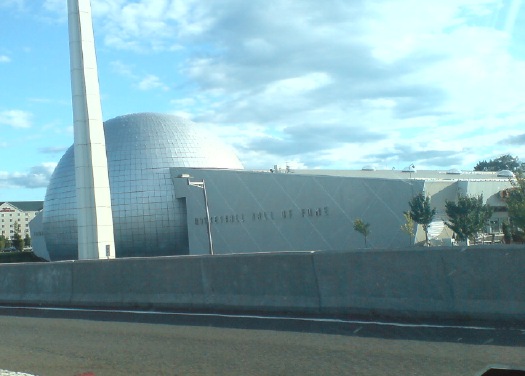
So there I am, just driving to the Berkshires for an interview, minding my own business, when suddenly I come around the bend into Springfield, MA, and there’s Charles Gwathmey throwing a 100-foot silver sphere in my face!
And I’m all, fine, you and the Naismith Memorial Basketball Hall of Fame win this round, but I will be bringing my satelloon game in the playoffs, my dearly departed friend.
Naismith Memorial Basketball Hall of Fame (2002) [gwathmey-siegel.com]
Tools And Tactics Aren’t Art’s Alone
I can’t quite figure out how it ties to the rest of the story, but I still think Sean O’Toole just shortlisted himself for arts lede of the year:
For every Joseph Beuys and Yves Klein there is a fascist doppelgänger who also believes in the transformative potential of paint on the human body.
Alright, I am listening:
In 1999, shortly after trespassing onto a white farmer’s property southeast of Johannesburg, Moses Nkosi, 21, was stripped, his naked body painted silver by the landowner and his black assistant. An anomalous brand of vigilantism, this was repeated again a year later when a 14-year-old girl accused of shoplifting underwear was similarly stripped and painted by a white store manager and her black assistant.
Don’t Show That! [frieze.com]
